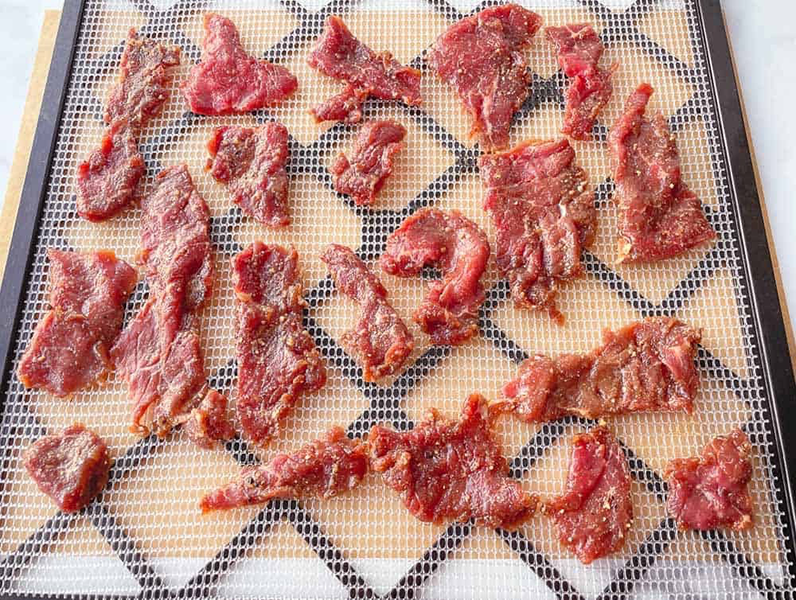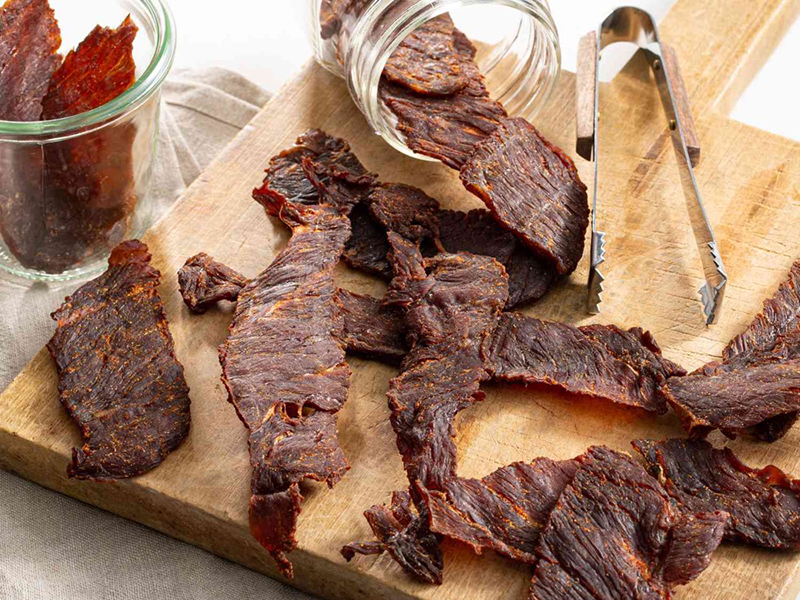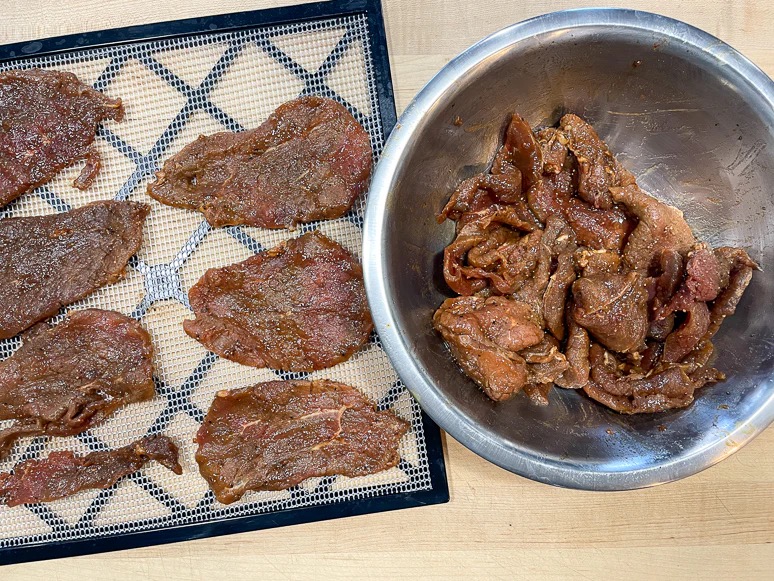
Content Menu
● Understanding the Food Dehydrator
● Benefits of Making Jerky at Home
● Choosing the Right Meat
● Preparing the Meat
● Dehydrating the Jerky
● Tips for Successful Jerky Making
● Storing Your Jerky
● Troubleshooting Common Issues
● Additional Insights on Jerky Varieties
● Flavor Variations
● Health Considerations
● Final Thoughts on Jerky Making Process
● Conclusion
● FAQ
>> 1. What type of meat is best for making jerky?
>> 2. How long should I marinate my meat?
>> 3. What temperature should I set my dehydrator?
>> 4. How long does it take to dehydrate jerky?
>> 5. How should I store homemade jerky?
● Citations:
Making jerky at home using a food dehydrator is a rewarding and straightforward process. This guide will walk you through the steps to create delicious beef jerky, ensuring you understand the equipment, ingredients, and techniques necessary for success.

Understanding the Food Dehydrator
A food dehydrator is an appliance designed to remove moisture from food, allowing it to be preserved for longer periods. It works by circulating warm air around the food, which helps to evaporate moisture. When making jerky, the dehydrator is essential because it provides a controlled environment for drying meat evenly and efficiently.
Benefits of Making Jerky at Home
- Healthier Option: Homemade jerky allows you to control the ingredients, avoiding preservatives and excess sodium found in store-bought varieties.
- Cost-Effective: Making your own jerky can save money compared to purchasing pre-packaged products.
- Customization: You can experiment with different marinades and spices to create flavors that suit your taste.
Choosing the Right Meat
The first step in making jerky is selecting the appropriate cut of meat. The best options are lean cuts with minimal fat content, as fat can spoil and affect the shelf life of your jerky. Here are some recommended cuts:
- Eye of Round Roast
- Top Round Roast
- Flank Steak
- Sirloin Tip
- Ground Beef (10% fat or less)
Preparing the Meat
1. Slicing: Cut the meat into thin strips, ideally about 1/8 to 1/4 inch thick. For easier slicing, partially freeze the meat for about 1-2 hours beforehand.
2. Marinating: Marinate the sliced meat for flavor and preservation. A simple marinade can include:
- Soy sauce
- Worcestershire sauce
- Honey or brown sugar
- Garlic powder
- Black pepper
- Optional: red pepper flakes for heat
Combine these ingredients in a bowl or a resealable plastic bag, add the meat, and let it marinate in the refrigerator for at least 3 hours, preferably overnight.
Dehydrating the Jerky
Once marinated, it's time to dehydrate:
1. Preheat Your Dehydrator: Set your dehydrator to a temperature between 155°F to 165°F (68°C to 74°C).
2. Arrange the Meat: Lay the marinated strips on the dehydrator trays in a single layer, ensuring they do not overlap. This allows for even airflow and drying.
3. Dehydrate: Drying time can vary based on thickness and humidity but generally ranges from 4 to 6 hours. Start checking for doneness around the 4-hour mark:
- The jerky should bend without breaking.
- It should be dry but still somewhat pliable.
4. Cooling: Once done, remove the jerky from the dehydrator and let it cool completely on paper towels.
Tips for Successful Jerky Making
To ensure your jerky turns out perfectly every time, consider these additional tips:
- Use Fresh Ingredients: Always start with fresh meat and high-quality marinade ingredients. This will significantly impact the flavor of your final product.
- Uniform Slices: Aim for uniform thickness when slicing your meat; this ensures even drying throughout the process.
- Rotate Trays: If your dehydrator has multiple trays, rotate them every couple of hours to promote even drying. This is especially important in dehydrators with vertical airflow[6].
- Check Frequently: Begin checking your jerky after about three hours of drying time. Depending on humidity levels and thickness of slices, some batches may take longer than others[5].

Storing Your Jerky
Store your homemade jerky in airtight containers or vacuum-sealed bags. It can last for several weeks at room temperature or up to six months if refrigerated or frozen.
Troubleshooting Common Issues
Even experienced jerky makers can encounter problems. Here are some common issues and how to fix them:
- Jerky is Too Tough: If your jerky is overly tough, it may have been dehydrated too long or sliced too thinly. In future batches, try reducing drying time or slicing thicker pieces.
- Jerky is Too Soft: If your jerky feels too soft or moist after drying, it likely needs more time in the dehydrator. Ensure that it cracks slightly when bent but does not break completely[1].
- Flavor Issues: If your jerky lacks flavor, consider increasing marinating time or experimenting with different spices and seasonings in your marinade[8].
Additional Insights on Jerky Varieties
While beef jerky is incredibly popular, there are numerous other meats you can use:
- Turkey Jerky: A leaner alternative that offers a different flavor profile.
- Pork Jerky: Can be made from cuts like tenderloin; however, ensure proper cooking temperatures due to safety concerns with pork.
- Venison Jerky: A favorite among hunters; its unique flavor pairs well with robust marinades.
Experimenting with different meats can add variety to your snacks!
Flavor Variations
You can create an array of flavors by adjusting your marinade ingredients:
- Spicy Teriyaki: Add sriracha sauce and sesame oil.
- Sweet BBQ: Incorporate BBQ sauce with brown sugar.
- Smoky Chipotle: Use chipotle peppers in adobo sauce for a smoky kick.
These variations not only enhance taste but also allow you to cater to different palates within your family or friends[9].
Health Considerations
When making homemade jerky:
- Monitor sodium levels in marinades if you're concerned about salt intake.
- Consider using low-sodium soy sauce or natural sweeteners like agave syrup instead of sugar.
Additionally, always ensure that meats reach safe internal temperatures during preparation (160°F for beef) before dehydration[3].
Final Thoughts on Jerky Making Process
As you embark on making homemade jerky using a food dehydrator:
1. Embrace experimentation; don't hesitate to try new flavor combinations.
2. Document each batch's process so you can refine recipes over time.
3. Share your creations! Homemade jerky makes an excellent gift during holidays or special occasions.
By embracing these practices and understanding how to use a food dehydrator effectively, you'll find that making beef jerky becomes not just a culinary task but an enjoyable hobby that yields delicious rewards!
Conclusion
Making beef jerky using a food dehydrator is not only simple but also allows you to enjoy a healthy snack tailored to your preferences. By following these steps—selecting quality meat, marinating effectively, and properly dehydrating—you can create delicious jerky that rivals store-bought options.

FAQ
1. What type of meat is best for making jerky?
Lean cuts such as eye of round roast, flank steak, or sirloin tip are ideal due to their low-fat content.
2. How long should I marinate my meat?
Marinating for at least 3 hours is recommended, but overnight yields better flavor.
3. What temperature should I set my dehydrator?
A temperature between 155°F to 165°F (68°C to 74°C) is optimal for dehydrating jerky safely.
4. How long does it take to dehydrate jerky?
Typically, it takes between 4 to 6 hours depending on the thickness of your meat strips and humidity levels.
5. How should I store homemade jerky?
Store in airtight containers or vacuum-sealed bags; it lasts several weeks at room temperature or up to six months in refrigeration or freezing.
Citations:
[1] https://extension.sdstate.edu/home-dried-jerky-process-and-tips
[2] https://www.youtube.com/watch?v=Wj-xTmebJBQ
[3] https://fyi.extension.wisc.edu/safepreserving/files/2015/07/Making_Safe-Jerky_in_a-Home_Dehydrator.pdf
[4] https://www.allrecipes.com/article/how-to-use-a-food-dehydrator/
[5] https://peopleschoicebeefjerky.com/blogs/news/how-to-make-beef-jerky-in-a-dehydrator
[6] https://ohioline.osu.edu/factsheet/hyg-5362
[7] https://delishably.com/meat-dishes/How-to-Make-Beef-Jerky-with-a-Dehydrator
[8] https://www.jerkyholic.com/how-to-make-beef-jerky-with-a-dehydrator/
[9] https://ediblecommunities.com/home-cooking/how-to-make-jerky-with-a-dehydrator/
[10] https://hiphipgourmet.com/recipe-for-beef-jerky-in-a-dehydrator/











